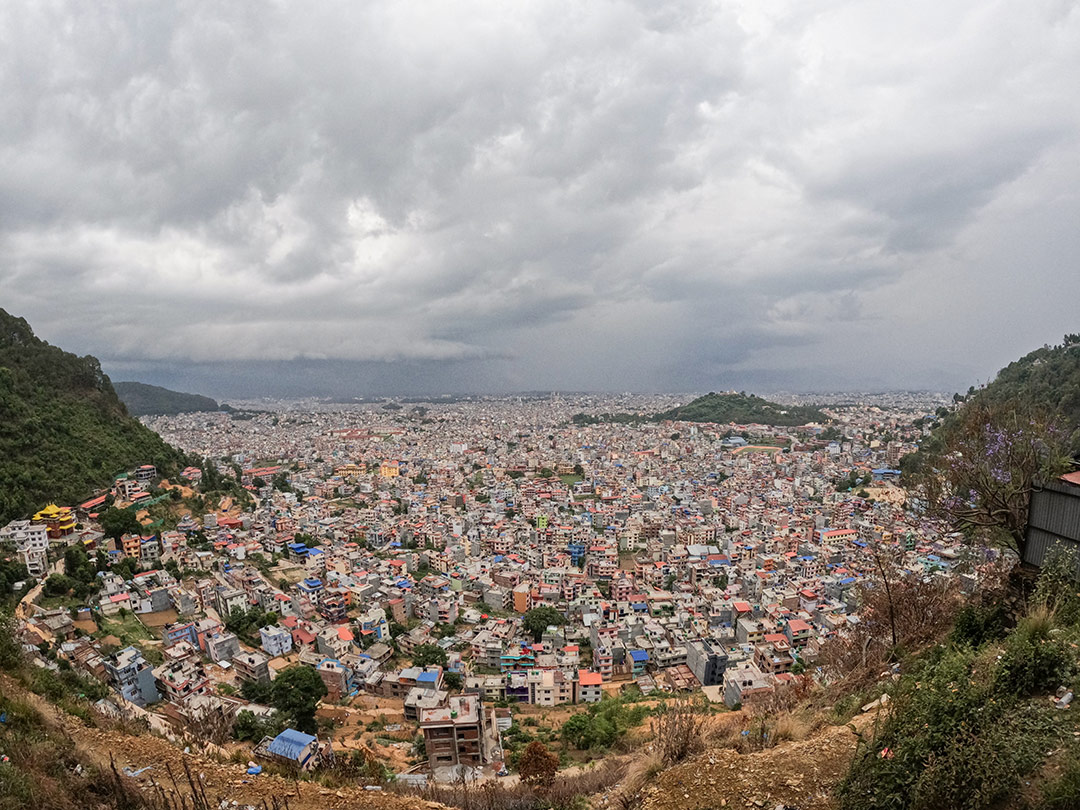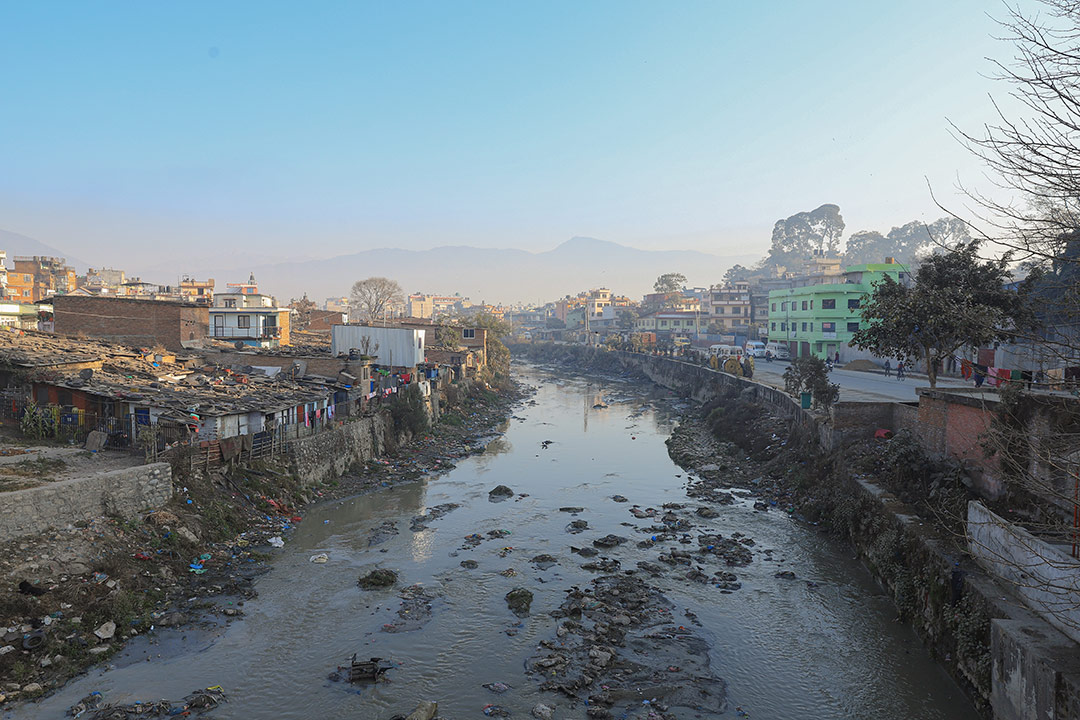Nepal is a complex region with varying topographic geographies, complexities, and compounding precarity. The unique young mountain geology, topographic variation from the cold northern Himalayan region, temperate Hilly, and hot southern Terai plains make the country distinct with varied ecosystems and rich natural resources, however, the fragile mountains and multifaceted poverty have made the country extremely prone to various geological and hydro-meteorological hazards like earthquakes, floods, landslides, droughts etc. More than 900 residents are killed annually by a variety of disasters, making it one of the most disaster-prone countries in the world (Shrestha, 2019).
Extreme heat is a silent hazard lurking for years, mainly in the hottest region Terai where summer temperature can reach up to 45ºC during heat waves and longer periods of drought with reported cases of annual heat mortality (Singh et al., 2014). In densely populated metropolitan areas in the Kathmandu Valley (the capital city) and the Terai region’s urban core (Nepalgunj, Chitwan, Biratnagar), the urban heat island effect (UHI) prolongs and intensifies heat waves amplifying morbidity and mortality during the heatwave events. Yet the dangers posed by heat has been unseen, and the awareness of the heat related human and economic devastation is insufficient due to the focus on other disaster planning priorities, years of unplanned urbanization with growing environmental, economic, and social problems, and government’s inability to adequately prioritize and respond to heat concerns.
The wicked intersection of multidimensional poverty, multitude disasters, and development interests has worsen the heat situation in the country, where one in ten residents are projected to live in excessive heat (Dhimal et al., 2018). However, most often, heat disasters in Nepal gets overlooked largely due to its prevailing global image of himalayan country and mountain economy. The scholarship discourse of heat has exhibited a sustained focus on historically hotter climatic zone and larger urban geographies, resulting in a lack of attention towards smaller urban contexts, such as Nepal, which harbors unnoticed hotter region, growing concerns of temperature extremes and dearth of empirical studies, a pattern consistent to historical hierarchies in disaster scholarship, perpetuating an inequitable distribution of attention and resources (Kotharkar & Gosh, 2021). Unfortunately, this is mirrored in country’s disaster preparedness, with little attention to heat impact in the hottest Terai region, where half its population is concentrated in one-third of the total area which routinely witnesses heat morbidity and heat associated mortality.
The silent nature of heat with no visual destruction, leads to low-risk perception, and inadvertently shifts government priorities to other socio-economic challenges, and development interests. The climate change policies have expanded to integrate extreme heat consideration into national urban development strategy but with no comprehensive heat plan and lack of strategic framework to advance proposed heat resiliency strategies, it has failed to yield tangible results. The full extent of heat impact is unknown as heat-related illnesses and excess deaths are not systematically tracked in Nepal and dearth of studies investigation heat trends, mortality, and morbidity across populations. Reliance on international agencies for financial resources, and science-techno competencies has led to an inherent favor of funders’ priorities over the country’s socioeconomic, environmental, and development interests (Apostolopoulou & Pant, 2022). The heat interventions proposed by these agencies are uncritically exported lessons from apparent urban climate success stories that overlook the historical context, microclimatic conditions and lack strategic framework to advance the heat resilience outcomes.

Nepal’s high-density Kathmandu Valley. Most urban centers in Nepal lack formal planning in practice with few green spaces or natural features to reduce the urban heat footprint.(Photo Credit: Samip- Sitaram Thapa Magar).
The impact of increasing extreme heat events are exacerbated by pressing regional urban issues due to years of unplanned urbanization, land use planning, and development patterns. Though first urban planning strategy was published in third national five-year plan in the late 60’s with subsequent town development act in 1988, lack of comprehensive land use policies results in unprecedented urban growth, land use change, increased impervious surface, lack of vegetation, increasing heat footprint, and notable shifts in micro-climatic conditions. The history of planning practice in Nepal have consistently exhibited a propensity to the ruling higher-class elites, thereby resulting in the allocation of resources predominantly concentrated in the capital city and major hilly urban hubs.
Terai region home to indigenous population was once considered undesirable for settlement due to risk of malaria and dengue fever, but country’s pre-democratic internal colonial policies set by higher caste hilly elites altered the narrative to serve massive natural resource extraction plan from the dense forest in Siwaliks or Churia hills.While it bought tremendous wealth to elites (Ojha, 1983) the region endured massive deforestation, a leading cause for huge loss of livelihood among the indigenous population in Terai followed by biodiversity loss, habitat destruction, and environmental degradation that paved path for present day disasters like floods, landslides, and groundwater loss. Once undesirable land, now began to see influx due to increased population pressure in hills, its fertile flat terrain providing both agricultural and industrial prospects over the years. The challenge of accommodating the burgeoning urban populace and fulfilling residents’ expectations for comprehensive municipal services became a common theme throughout the country. Results are acute housing crisis, increased informal settlements, encroachment of flood plains, inadequate provision of basic amenities like safe drinking water, sanitation, and waste systems.
Governmental inefficiency in delivering essential urban amenities, emergency services and basic health care, particularly to impoverished and marginalized communities, shifts disaster burden to the most vulnerable individuals who are already impacted by poverty, lack of access to cooling infrastructure, and prolonged power outages that are frequent across the nation. The residents in informal settlements, agricultural workers, daily wage earners, and street vendors primarily in Terai now need to make tradeoff between staying indoors during the afternoon to protect themselves from scorching heat at the expense of working hours, income, and livelihood which impacts their overall adaptative capacity to disasters.
The recent unprecedented extreme heat episodes across the globe necessitate Nepal’s need to move from motivational climate change discourse to risk-informed, coherent heat policy implementation and investment in interventions that include and empower the poorest and most vulnerable. With limited government leadership, the expectations of behavioral actions from the residents under multiple socio-economic stressors will likely promote a heat planning approach that is illusory, inequitable, and unfair. The country must revisit and re-evaluate climate change priorities while investing in data monitoring that advances empirical studies to understand climatological heat trends, region-specific heat threat assessment while tracking heat related mortality and morbidity. There is a need for a functional heat resilience action plan in both urban areas and rural Terai with the adequate community and residential-based heat adaptation strategies with clear implementation guidelines, tools, and practices prioritized by local, provincial, and national government.

High poverty settlements along Kathmandu Valley’s polluted river. The informal settlement throughout the country lack safe drinking water, sanitation, sewer and health services exacerbating the vulnerability of residents during extreme weather events. (Photo Credit: Samip- Sitaram Thapa Magar).
Empirically assessed vernacular designs that indigenous Tharu communities have been using for generations to combat extreme heat in hotter Terai region, in tandem with new climate-responsive architecture and engineering can offer a unique opportunity to create socially relevant climate resiliency strategies. Contextual policies and programs are needed to ensure access to passive cooling, shade structures (natural or built), communal cooling facilities, clean and safe water, and improved early warning systems during emergencies. Establishing national institutional and stakeholder coherence, cooperation across relevant sectors while establishing a dialogue to learn from best practices across other South Asian geographies grappling with similar extreme heat events can provide meaningful insights needed to create more robust heat resiliency efforts in Nepal. It can also unlock a new level of regional cooperation across South Asia, one of the most extensive and challenging transboundary disaster hotspots. As climate change exacerbates extreme heat waves across the globe, Nepal cannot afford to wait for another disaster to unfold.
Sajani Kandel is a Ph.D candidate in School of the environment at University of Massachusetts Boston. Her scholarly work intersects environmental science, climate science, and resiliency planning and use interdisciplinary climate justice approach to redistribute expertise in heat resiliency decision making.
Sharmila Shyangtan is a Ph.D student in Development and Sustainability Program at Asian Institute of Technology [AIT] University, Thailand. Her research focuses on indigenous people, education, livelihood, development, and sustainability.
All essays on Extreme Heat in Urban South Asia
Introduction: The Everyday Politics of Thermal Violence in Urban South Asia
Nausheen H. Anwar
Facing a Familiar Foe: Adapting to Heat in South Asia
Chandni Singh
The Paradox of Heat: Ubiquity, Invisibility, and Bodies in India
Ashawari Chaudhuri
Why focus on ‘heat’? A silent disaster unfolding in Nepal
Sajani Kandel and Sharmila Shyangtan
Heat (in)action: The Thermopolitics of Extreme Urban Heat in Karachi
Adam Abdullah and Soha Macktoom
Heat Relief as a Matter of Entitlement? The Socio-Materialities of Thermal Governance in an Informal Urban Settlement
Aalok Khandekar, Anant Maringanti, Anushree Gupta, and Tanaya Bhowal
Related IJURR articles on Extreme Heat and Climate Change in South Asia and Beyond
SOUTH ASIAN URBAN CLIMATES: Towards Pluralistic Narratives and Expanded Lexicons
Nida Rehman, Aparna Parikh, Zachary Lamb, Shruti Syal, D. Asher Ghertner, SiddhaRth Menon, Nausheen Anwar, Hira Nabi, Waqas Butt, Malini Ranganathan, Krithika Srinivasan, Harshavardhan Bhat, Anthony Powis and Nikhil Anand
ENDURING HARM: Unlikely Comparisons, Slow Violence and the Administration of Urban Injustice
Nikhil Anand, Bethany Wiggin, Lalitha Kamath and Pranjal Deekshit
URBAN WATERLINES: Socio-natural Productions of Indifference in an Indian City
Karen Coelho
TOWARDS A POSTCOLONIAL PERSPECTIVE ON CLIMATE URBANISM
Enora Robin and Vanesa Castán Broto
Day Zero and The Infrastructures of Climate Change: Water Governance, Inequality, and Infrastructural Politics in Cape Town’s Water
Nate Millington and Suraya Scheba
Resilient Growth: Fantasy Plans and Unplanned Developments in India’s Flood-Prone Coastal Cities
Liza Weinstein, Andrew Rumbach and Saumitra Sinha
Urban Waterscapes: The Hydro-Politics of Flooding in a Sinking City
Kian Goh
‘Eco’ For Whom? Envisioning Eco-urbanism in the Sino-Singapore Tianjin Eco-city, China
Federico Caprotti, Cecilia Springer and Nichola Harmer
Maintaining Climate Change Experiments: Urban Political Ecology and the Everyday Reconfiguration of Urban Infrastructure
Vanesa Castán Broto and Harriet Bulkeley
Strategic Bundling of Development Policies with Adaptation: An Examination of Delhi’s Climate Change Action Plan
Rimjhim M. Aggarwal
Urban Responses to Climate Change: Theories and Governance Practice in Cities of the Global South
Dirk Heinrichs, Kerstin Krellenberg and Michail Fragkias
Climate Change Adaptive Capacity in Santiago de Chile: Creating a Governance Regime for Sustainability Planning
Jonathan R. Barton
